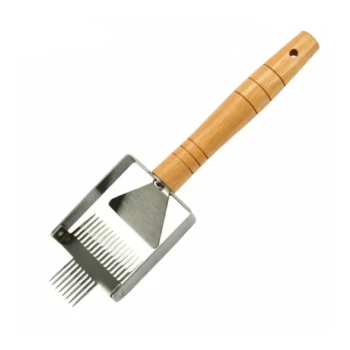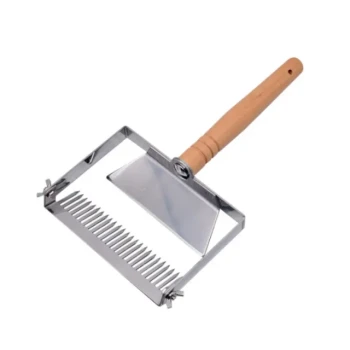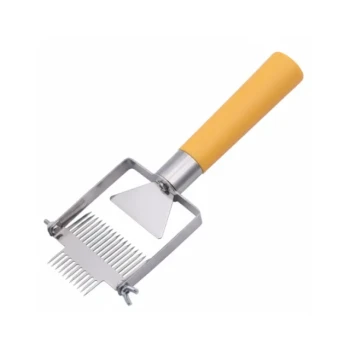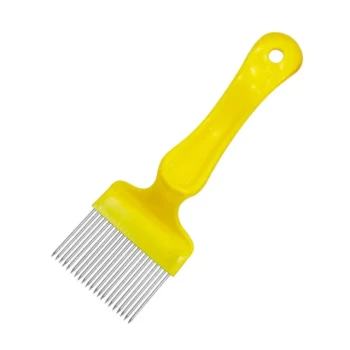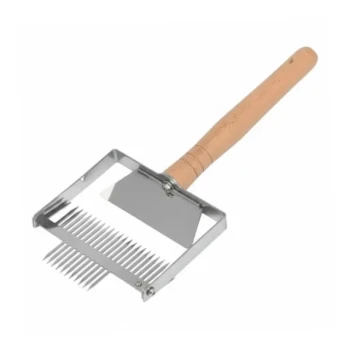At its core, the two most essential handling tools for a honey harvest are a bee brush and an uncapping tank. The brush allows you to gently and safely clear bees from the frames, while the tank serves as your primary workstation for holding frames, collecting wax cappings, and catching every drop of honey.
A successful and low-stress honey harvest is less about brute force and more about efficient workflow. Your choice of handling tools directly impacts bee agitation, your own efficiency, and the final quality and quantity of your honey.
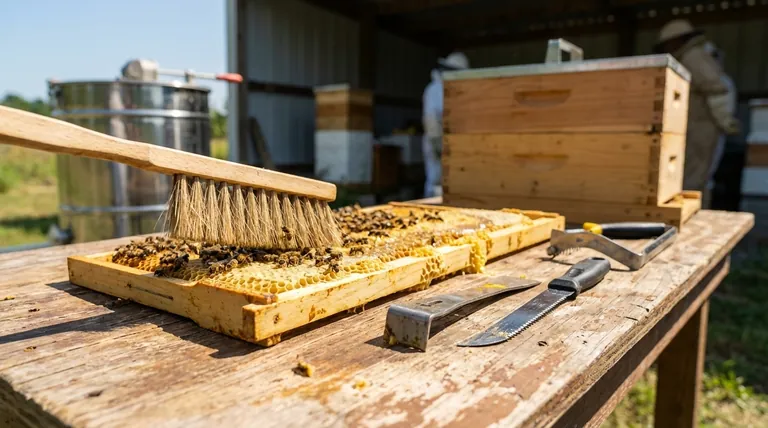
The Core Tools for Managing Bees and Frames
The first stage of the harvest involves removing frames from the hive. The goal is to do this calmly and securely, causing minimal disruption to the colony.
The Bee Brush: Gentle Persuasion
A bee brush is a soft-bristled tool designed specifically to sweep bees off a frame of honey. Its purpose is to gently persuade bees to move without harming them or triggering a defensive response.
This simple tool is fundamental for clearing the last few bees before taking frames away from the hive for processing.
Hive Tools and Frame Grips: Secure Control
Before you can brush bees off, you must be able to lift the frames. A hive tool is essential for prying apart frames that bees have sealed together with propolis.
A frame grip clamps onto the top of a frame, allowing you to lift it straight up with one hand. This provides a secure hold, preventing accidental drops that can injure bees and damage delicate comb.
Tools for an Efficient Harvesting Workflow
Once you move the frames indoors to a bee-proof area, your handling tools shift from managing bees to processing honey. This is where your setup determines your speed and cleanliness.
The Uncapping Tank: Your Primary Workstation
An uncapping tank is the centerpiece of your operation. In its simplest form, it's a container with a rack to hold frames while you work.
More advanced double uncapping tanks have a top section with a screen that allows honey to drain from the wax cappings into a collection tank below. This system ensures you save every bit of wax and honey during the process.
Uncapping Tools: Opening the Honey Cells
To release the honey, you must first remove the thin beeswax cappings from the cells. This is done over your uncapping tank.
Common tools for this include a serrated uncapping knife, an uncapping fork (or scratcher) for getting into low spots, or a spiked roller.
Buckets and Strainers: The Collection Point
You will need at least one food-grade bucket with a honey gate (a type of spigot) at the bottom. This is placed under your extractor or press to collect the processed honey.
A strainer, often a double-sieve system that fits over the bucket, is used to filter out wax particles, bee parts, and other debris as the honey is collected.
Understanding the Trade-offs: Extractor vs. Press
How you separate honey from the comb is the biggest decision in the process. Each method has distinct advantages and requires different equipment.
The Centrifugal Extractor
An extractor uses centrifugal force to spin honey out of the cells. Its key advantage is that it leaves the beeswax comb intact.
The bees can then reuse this comb, saving them an enormous amount of energy they would otherwise spend rebuilding it. This is the standard for beekeepers who want to maximize honey production.
The Honey Press
A honey press works by crushing the entire comb to squeeze the honey out. This method is efficient and captures all the honey, but it destroys the comb.
The resulting beeswax is a valuable byproduct, but the bees must start from scratch to rebuild the comb in the frame. This method is often preferred for comb that is old, dark, or not suitable for extraction.
Making the Right Choice for Your Goal
Your investment in handling tools should align with the scale of your operation and your long-term goals as a beekeeper.
- If your primary focus is a small-scale hobby (1-3 hives): A bee brush, hive tool, and a simple bucket-and-strainer system for crush-and-strain extraction is a perfectly effective and low-cost start.
- If your primary focus is efficiency and growth: Investing in a double uncapping tank and a small centrifugal extractor will dramatically reduce your labor and processing time.
- If your primary focus is preserving the comb for reuse: A centrifugal extractor is the only choice, as it is designed to keep the valuable drawn comb intact for the bees.
Ultimately, equipping yourself with the right tools transforms honey harvesting from a chaotic chore into a clean, efficient, and rewarding experience.
Summary Table:
| Essential Tool | Primary Function | Key Benefit |
|---|---|---|
| Bee Brush | Gently clear bees from frames | Minimizes bee agitation and stress |
| Uncapping Tank | Workstation for uncapping and draining | Collects all honey and wax, improves cleanliness |
| Hive Tool & Frame Grip | Pry apart and securely lift frames | Prevents damage to comb and bees |
| Extractor vs. Press | Separate honey from comb (reusable vs. crush) | Maximizes yield and aligns with beekeeping goals |
Ready to build a more efficient honey harvest?
As a trusted wholesale supplier to commercial apiaries and equipment distributors, HONESTBEE provides the durable, high-performance tools you need. From heavy-duty uncapping tanks to reliable extractors, our equipment is designed to maximize your yield and streamline your workflow.
Contact our team today to discuss your operation's needs and discover how our supplies can help you achieve a more productive and profitable season.
Visual Guide
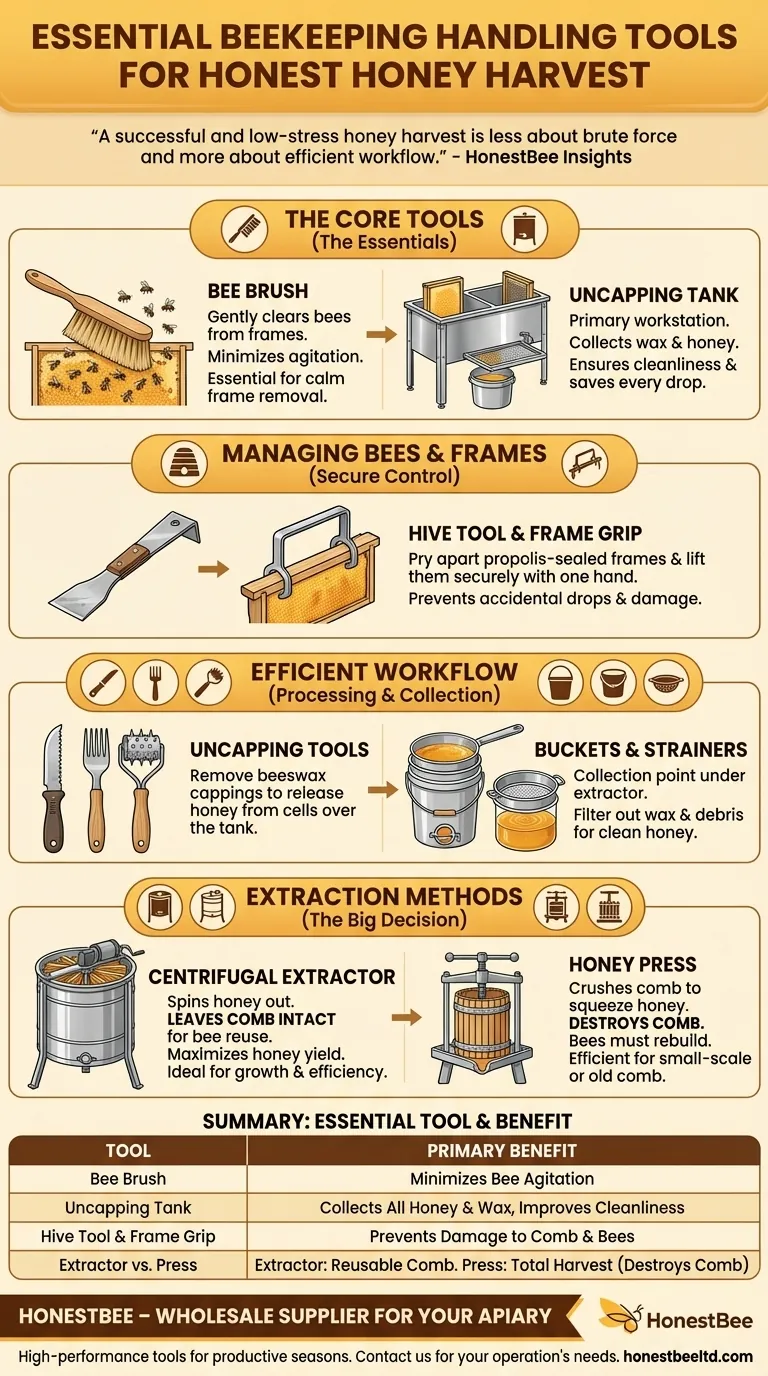
Related Products
- Premium Traditional Copper Bee Smoker with Bellows
- Plastic Handle Single Row Artificial Fiber Bee Brush
- Double-Sided Pivoting Honey Uncapping Fork with Scraper for Beekeeping
- Wide Adjustable Stainless Steel Honey Uncapping Fork with Scraper
- Double Sided Adjustable Honey Uncapping Fork with Plastic Handle
People Also Ask
- What are the main components of a bee smoker? A Guide to Safe and Effective Hive Management
- What is a Smoker and how is it used in beekeeping? The Essential Tool for Calm, Safe Hive Inspections
- What are the benefits of using smoke properly in beekeeping? Achieve Calm, Safe Hive Inspections
- What is the primary purpose of using smoke in beekeeping? Calm Bees for Safer Hive Management
- How did early beekeepers use bee smokers? Master Ancient Bee Calming Techniques


